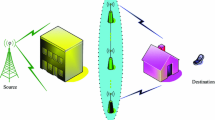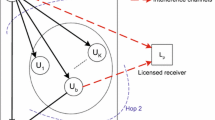Abstract
In cooperative communication, different ratio combining approaches can be utilized at the receiver based on the channel state information (CSI) available to the destination. In this paper, we focus on optimal energy allocation under amplify-and-forward (AF) cooperative communications when various ratio combining methods are utilized. More specifically, we consider a suite of important and fundamental problems, including signal-to-noise ratio (SNR) maximization under a weighted total energy constraint, weighted total energy minimization under an SNR constraint, weighted total energy minimization under an outage probability constraint and outage probability minimization under instantaneous weighted total energy constraint, and analyze the relationship among these problems. We first consider maximal ratio combining (MRC) and derive exact analytical solutions. To reveal the key factors in the resource allocation problem, we further transform the exact results with multiple parameters into more intuitive results with only two quantities. The resulting solutions provide a new perspective to understand optimal energy-efficient opportunistic cooperative transmissions. We then consider fixed ratio combining (FRC) and show that an explicit analytical solution does not exist to the original problem. To this end, based on the convexity proofs for the objective functions, we utilize numerical convex optimizations to obtain the unique solution. Both numerical and simulation studies are conducted to validate our theoretical analysis.
Similar content being viewed by others
References
Cover T M, Gamal A A E. Capacity theorems for the relay channel. IEEE Trans Info Theory, 1979, 25: 572–584
Sendonaris A, Erkip E, Aazhang B. User cooperation diversity—part I: System description. IEEE Trans Commun, 2003, 51: 1927–1938
Sendonaris A, Erkip E, Aazhang B. User cooperation diversity—part II: Implementation aspects and performance analysis. IEEE Trans Commun, 2003, 51: 1939–1948
Laneman J N, Wornell G W, Tse D N C. An efficient protocol for realizing cooperative diversity in wireless networks. In: Proceedings of IEEE International Symposium on Information Theory, Washington DC, 2001
Scaglione A, Goeckel D L, Laneman J N. Cooperative communications in mobile ad hoc networks. IEEE Signal Process Mag, 2006, 23: 18–29
Hunter T E, Nosratinia A. Cooperative diversity through coding. In: Proceedings of IEEE International Symposium on Information Theory, Laussane, 2002
Hunter T E, Nosratinia A. Diversity through coded cooperation. IEEE Trans Wirel Commun, 2006, 5: 283–289
Gunduz D, Erkip E. Opportunistic cooperation by dynamic resource allocation. IEEE Trans Commun, 2007, 6: 1446–1454
Zhao Y, Adve R, Lim T J, Improving amplify-and-forward relay networks: optimal power allocation versus selection. IEEE Trans Commun, 2007, 6: 3114–3123
Li J, Ge J H, Wang Y, et al. A bandwidth efficient two-user cooperative diversity system with limited feedback. Sci China Ser F-Inf Sci, 2009, 52: 1055–1066
Xu X R, Zheng B Y. A novel multi-relay cross-layer cooperative communication strategy based on Jackson queuing model. Sci China Inf Sci, 2010, 53: 842–853
Zhang G P, Yang K, Ding E J. Power allocation scheme for selfish cooperative communications based on game theory and particle swarm optimizer. Sci China Inf Sci, 2010, 53: 1908–1912
Ding E J, Zhang G P, Liu P, et al. Energy-efficient power allocation for selfish cooperative communication networks using bargaining game. Sci China Inf Sci, 2012, 55: 795–804
Yang D J, Fang X, Xue G L. Game theory in cooperative communications. IEEE Wirel Commun, 2012, 19: 44–49
Wang Q, Ren K, Zhang Y C, et al. Opportunistic cooperation with receiver-based ratio combining strategy. In: Proceedings of International Conference on Wireless Algorithms, Systems, and Applications. Berlin/Heidelberg: Springer-Verlag, 2008. 361–372
Zhu H L, Wang J Z. Chunk-based resource allocation in OFDMA systems—Part I: chunk allocation. IEEE Trans Commun, 2009, 57: 2734–2744
Author information
Authors and Affiliations
Corresponding author
Rights and permissions
About this article
Cite this article
Wang, Q., He, M., Song, W. et al. Energy efficient opportunistic cooperative transmission with different ratio combinings: from a new perspective. Sci. China Inf. Sci. 57, 1–14 (2014). https://doi.org/10.1007/s11432-013-4886-6
Received:
Accepted:
Published:
Issue Date:
DOI: https://doi.org/10.1007/s11432-013-4886-6




